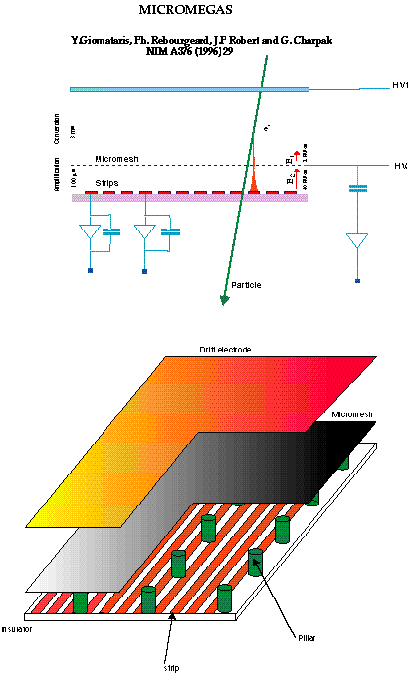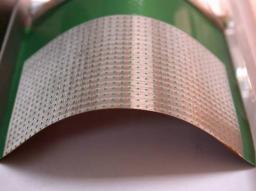Objectives
The Micromegas detector was designed for high energy physics detectors, in particular for very high particle fluxes. This R&D effort aims to improve the performance, the efficiency and the robustness of Micromegas-based detectors.
Neutron or photon detection is made possible with the addition of a converter on the drift window. These designs may require to operate the detector in sealed mode, especially when used in hostile environments. The Piccolo neutron detector, designed to work at high temperature, is intended for use in a nuclear core for ADS research. Another project aims to apply the micromegas technique to detect photons, under very stringent cleanness constraints.
A new fabrication process called Micromegas Bulk was developed in 2004 by DAPNIA and CERN. With this very promising technique, robust and large detectors of various sizes and shapes can be built. The bulk process uses printed circuit board photolithography techniques to form the detector amplification region, assembling the parallel conductive mesh and the detector PCB readout plane with a forest of microscopic pillars. This technology is being used by DAPNIA for the readout plates of the three Time Projection chambers (TPCs) of the T2K experiment, each plate being a mosaic of 12 large (34x36 cm²) detectors with very small dead space. The bulk technique also leads the design of thin cylindrical micromegas detectors for the JLAB CLAS12 tracker. From an R&D point of view, the bulk technology opens the path to a wide range of possibilities, such as multiple or segmented mesh, and integration of electronic chips on the detector board.
Within the development framework of a large TPC for the International Linear Collider, a resistive coating was used in order to spread the avalanche on the readout plane. This technique increases the spatial resolution and decreases the sparking probability, thus allowing higher detector gains. With a resistive layer applied on 2.3 mm wide pads, an extremely good 50 µm spatial resolution could be obtained (collaboration with Carleton University, Ottawa).
The combination of Micromegas with Medipix2 and Timepix CMOS pixel sensor chips (collaboration with CERN and Nikhef, Amsterdam) was realized and opens the way to very fine 3D granularity. In the same direction, the first tests trying to integrate a Micromegas detector on a silicon layer (InGrid) are very promising.
Collaborations
RD51, CERN (2007+): International R&D collaboration on Micro-Pattern Gaseous Detectors (MPGD), in association with GEM detector proponents.
R&D project sponsored by the french national research agency (ANR): MIMAC (MIcro -tpc MAtrix of Chambers), a new generation detector for non -baryonic dark matter search, in association with LPSC Grenoble, 2008-10.
EUDET, Detector R&D towards the International Linear Collider
Dapnia Contribution
Realisation and characterisation of the Micromegas detectors. Data analysis and interpretation in the experiments where a Micromegas detector is being used.
Realisation of the Bulk technology, now at a mature stage, after being used and improved in the T2K detector.
Communication efforts in order to introduce the Micromegas detector in new groups, new institutes by means of many conferences (in Paris and Berkeley) dedicated to the technique.
Contact
• Institut de recherche sur les lois fondamentales de l'Univers (Irfu) • Le Département d'Électronique des Détecteurs et d'Informatique pour la Physique (DEDIP)





